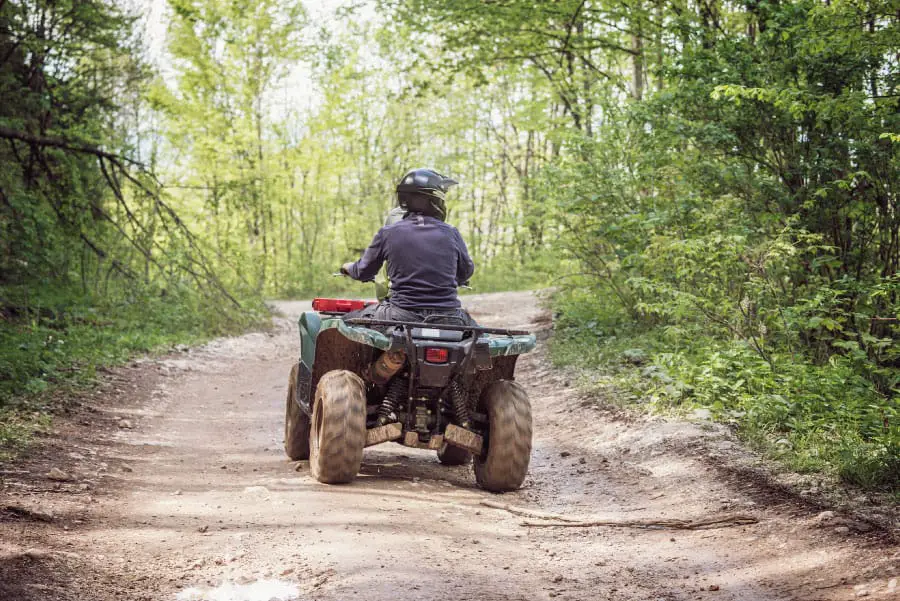
Push starting a vehicle is a way of starting an engine if the battery is dead or does not have sufficient charge to turn the starter motor. This method of starting the engine is also known as bump starting or popping the clutch and is usually used for manual transmission vehicles.
Is there a similar method to starting automatic vehicles, specifically your ATV, if the battery is not operating at optimal capacity? Generally, only ATV’s with certain types of automatic transmissions can be push-started safely. If you try to push-start an automatic ATV with the incorrect transmission type, it will at best not start and, at worst, cause damage to the transmission.
If your ATV can be push-started safely, then here are 3 steps to get your ATV started.
- Get your ATV to the top of an incline or steep driveway.
- Put the ATV is gear.
- Get on the ATV and roll down the hill to gain speed and start the engine.
There may only be three steps to this push-start procedure, but there is more to the three steps than what first glance portrays.
Remember: Before trying any push-start method on your automatic transmission ATV, you need to make sure it is capable of starting using this method and that no damage will be caused by attempting this method!
Push Starting Your Automatic ATV
Many ATV riders will tell you that you cannot push-start an automatic ATV, and in most instances, they are correct. Some automatic transmissions require the parts of the gearbox to be rotating before a gear can be selected, while others rely on the compression of a running engine to engage the clutch.
There are, however, some ATVs that can be started using this method, particularly if they have hydraulic pumps.
- Get your ATV to the top of an incline or steep driveway. The goal here is to get some elevation so that you can get sufficient momentum as you roll the ATV down the hill. The incline that you use as a starting point will, therefore, need to be high enough and have a steep enough angle to achieve this purpose.
- Put the ATV in gear. At the top of the hill, climb aboard the ATV and put it in gear before launching yourself from the crest of the hill.
- Roll the ATV downhill. This is where it is useful to have a second person to give you a boost to help get you started. Get your assistant to give you a running push to start you on your downward trajectory. Once you have gained sufficient speed and momentum, the engine should turn over and fire, starting the ATV.
This process can be an exhausting undertaking if you are doing is all using man-power. Pushing an ATV up a hill may require what some would consider superhero-type strength! After pushing your ATV to the top of a hill two or three times, you will begin to wonder why you started off-roading on your ATV to begin with!
The physical effort required to perform this task repeatedly may prompt you to employ another method to gain the necessary momentum to start the ATV. You may try towing your ATV with another ATV or behind a truck.
This is, however, a potentially hazardous way to try and start your ATV, and you should weigh up the risks to determine if it is really worth it.
If you struggle to push-start your ATV or your transmission does not allow for this starting method to be used, you may want to try one of these other methods to get your ATV fired up!
Can I Start My ATV With Jump Cables?
Another method commonly used to start vehicles with battery problems is to use jumper cables from one vehicle’s battery to another.
The idea behind the jumper cable method is that the vehicle with a battery that is in good working order will supply a charge to the problematic battery. This charge should be enough to allow the engine to be started.
This is a well-known and widely used method in vehicles that are of the same type but requires some care when you are attempting this method with vehicles that are different.
For example, using another ATV to connect to your ATV battery is a safe method. Make sure the batteries are connected positive to positive and negative to negative. Start the donor ATV and wait a few minutes while it delivers charge to the ailing ATV. It sometimes helps to keep the revs slightly elevated on the ATV that is doing the charging. After a few minutes, try starting the ATV normally with the leads connected and the second ATV running.
If the ATV is still struggling to start, you may want to try and let it charge a bit longer before trying to start it again.
A second example is using a car or truck to provide the charge, and this is where some additional care needs to be exercised due to the differences between the two vehicles.
When using a car as the charging vehicle, you can connect the cables to the battery as normal, but leave the car turned off. Do not switch on the ignition or start the car as the differences in the electrical systems may cause damage to your ATV or the car.
With the batteries connected, wait a couple of minutes for a charge to build up in the ATV battery and then try to start the engine of the ATV. Hopefully, you should be able to get your ATV running after a couple of attempts.

Will My ATV Start If The Battery is Dead?
If your ATV battery is completely dead in that it does not even power the ignition lights to some degree, then the problem of starting your ATV takes on a different dimension.
With a completely dead battery, it may be possible to get the engine started using the push-start or bump-start method, but the battery may not hold the charge. If your battery is in this condition, it will not be able to successfully store a large enough charge to start the engine after the ATV has been switched off.
If you are using the cable start method, you may fail to get the ATV to start at all. This is because this method depends on the good battery being able to charge up the flat battery to the point that it can start the engine. If the flat battery is faulty and unable to hold a charge, then this method may not work to get the ATV started.
If your battery is in this condition, the only solution is to replace the battery with a new one. This should solve much of your ATV starting problems.
Are There Other Ways To Start Your ATV?
If the battery is the cause of your starting problems on your ATV and the methods already mentioned are not achieving any success for you, then you may wonder if there are any other options.
Unfortunately, due to the simplicity of the way the battery system works, there are not many different ways to achieve a current flowing in the circuit. Your only other option may be to take your ATV to a mechanic for a professional diagnostic to be run to establish the problem.
Some methods are purported to work, such as connecting a drill with an impact socket to the flywheel nut and running the drill in reverse. If the ATV is in neutral, the ignition is on, and the kill switch is in the on position, the drill can turn the flywheel sufficiently to induce a current in the coil enough to provide a spark.
This method may seem easy, but it lacks some practicality, as it only works on smaller engines and requires you to have a drill and impact socket on hand at the time your ATV won’t start!
Conclusion
Starting issues caused by battery problems are notorious for appearing at the most inconvenient times, such as when you have no tools at hand or a fellow off-roader to help you out. This should not be looked at as a downside to the activity, but rather as a part of the adventure that is ATV off-roading!
Choose to learn from the experience so that you are better prepared the next time the problem occurs, or you are in a position to help another off-roader who suffers from the predicament!
Happy ATV’ing!


